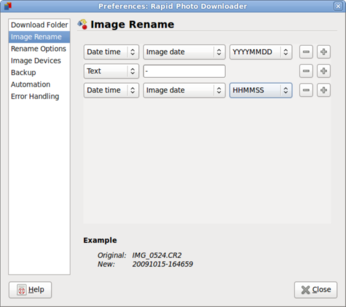Speed up Photo Transfers with Rapid Photo Downloader

Productivity Sauce
When you need to offload photos from a digital camera onto your computer, you can do this using the default browser, a photo management application, or a dedicated tool like Rapid Photo Downloader. Despite its name, transferring photos is only one of Rapid Photo Downloader's many talents. For starters, it can simultaneously download photos from multiple sources, so if your camera has two card slots, you can transfer photos from both of them in one go. More importantly, using Rapid Photo Downloader's preferences, you can configure the way the utility processes and sorts the downloaded photos. In the Download Folder section of the Preferences dialog window, you can specify the destination folder and define rules for organizing the downloaded photos into subfolders. For example, you can create a rule that moves photos taken on a specific date into a separate subfolder. This way the photos taken on October 19, 2009 are downloaded into the /2009/20091019 subfolder, while photos from November 1, 2009 are downloaded into the /2009/20091101 subfolder. Rapid Photo Downloader can also rename photos during download using user-defined rules. For example, using the rule shown in the figure below, Rapid Photo Downloader renames photos using the date and time information from the photo's EXIF metadata. So the utility replaces a meaningless file name like DSC_0023.JPG with 20091101-135533.JPG.
The Backup section lets you specify a destination directory where Rapid Photo Downloader will store backup copies of the downloaded photos. For example, you can specify an external USB storage device as the backup destination, and Rapid Photo Downloader will automatically back up the photos while downloading them from your camera.
Rapid Photo Downloader's Web site offers detailed instructions on how to install the application on different Linux distributions using binary packages. Alternatively, you can install Rapid Photo Downloader using the source distribution, and the INSTALL file supplied with the tarball archive provides a step-by-step guide on how to do this.
comments powered by DisqusSubscribe to our Linux Newsletters
Find Linux and Open Source Jobs
Subscribe to our ADMIN Newsletters
Support Our Work
Linux Magazine content is made possible with support from readers like you. Please consider contributing when you’ve found an article to be beneficial.

News
-
Zorin OS 18 Hits over a Million Downloads
If you doubt Linux isn't gaining popularity, you only have to look at Zorin OS's download numbers.
-
TUXEDO Computers Scraps Snapdragon X1E-Based Laptop
Due to issues with a Snapdragon CPU, TUXEDO Computers has cancelled its plans to release a laptop based on this elite hardware.
-
Debian Unleashes Debian Libre Live
Debian Libre Live keeps your machine free of proprietary software.
-
Valve Announces Pending Release of Steam Machine
Shout it to the heavens: Steam Machine, powered by Linux, is set to arrive in 2026.
-
Happy Birthday, ADMIN Magazine!
ADMIN is celebrating its 15th anniversary with issue #90.
-
Another Linux Malware Discovered
Russian hackers use Hyper-V to hide malware within Linux virtual machines.
-
TUXEDO Computers Announces a New InfinityBook
TUXEDO Computers is at it again with a new InfinityBook that will meet your professional and gaming needs.
-
SUSE Dives into the Agentic AI Pool
SUSE becomes the first open source company to adopt agentic AI with SUSE Enterprise Linux 16.
-
Linux Now Runs Most Windows Games
The latest data shows that nearly 90 percent of Windows games can be played on Linux.
-
Fedora 43 Has Finally Landed
The Fedora Linux developers have announced their latest release, Fedora 43.

